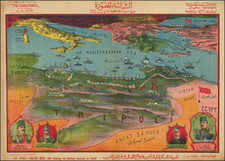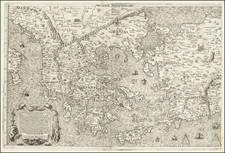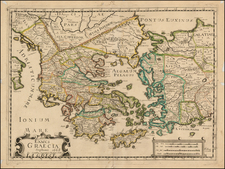Tabula Asiae I, published in Venice in 1561 by the renowned Italian cartographer Girolamo Ruscelli, presents a detailed Ptolemaic perspective of Asia Minor. The map reaches from Constantinople to Armenia, encompassing regions such as Pontus et Bithynia, Galatia, Pamphilia, Licaonia, Caria, Lidia, Licya, and both Armenia Minor and Maior.
Born in the era of the Renaissance, this map is a testament to the revival of scholarly interest in the works of Claudius Ptolemy, the influential Greek-Roman scholar of the second century AD. Ruscelli's map embraces Ptolemaic cartographic principles, reflecting the blend of preserved ancient knowledge and contemporary 16th-century geographic understanding.
Asia Minor, the geographical area depicted in this map, was a region of significant historical and cultural intersection. The landmass, now primarily constituting modern-day Turkey, was a crossroads of civilizations, with rich layers of Greek, Roman, and Byzantine history. The detailed rendering of regions such as Constantinople (modern Istanbul), the heart of the Byzantine Empire, and Armenia, an ancient kingdom with a distinct cultural heritage, illuminates the historical complexity of the region.
In sum, the Tabula Asiae I offers a unique historical and cartographic perspective on Asia Minor. As a synthesis of Ptolemaic tradition and Renaissance inquiry, it serves not only as a testament to the evolving understanding of the world in the 16th century but also as a rich tapestry of the historical and geographical complexities of the region it depicts.
Girolamo Ruscelli (1500-1566) was a cartographer, humanist, and scholar from Tuscany. Ruscelli was a prominent writer and editor in his time, writing about a wide variety of topics including the works of Giovanni Boccaccio and Francesco Petrarch, Italian language, Italian poetry, medicine, alchemy, and militia. One of his most notable works was a translation of Ptolemy’s Geographia which was published posthumously.
There is limited information available about Ruscelli’s life. He was born in the Tuscan city of Viterbo to a family of modest means. He was educated at the University of Padua and moved between Rome and Naples until 1548, when he moved to Naples to work in a publishing house as a writer and proofreader. He remained in the city until his death in 1566.










![[Persia and the Middle East]](https://storage.googleapis.com/raremaps/img/small/63394kb.jpg)



